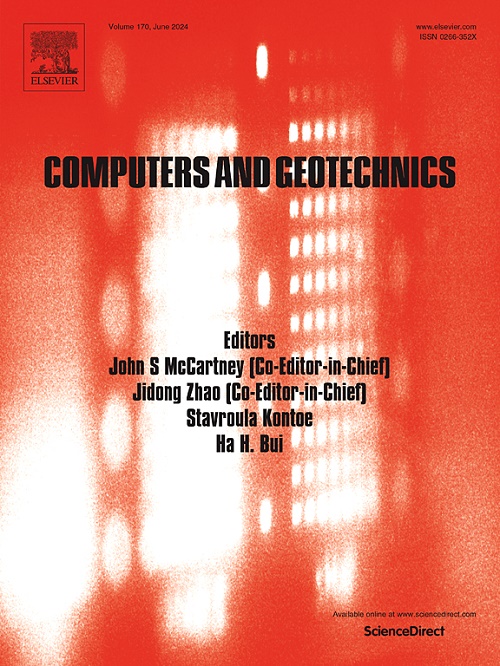CO2压裂的相场模拟:天然裂缝和地层层间对比的影响
IF 6.2
1区 工程技术
Q1 COMPUTER SCIENCE, INTERDISCIPLINARY APPLICATIONS
引用次数: 0
摘要
CO2压裂在提高石油采收率方面的显著优势已得到公认。在这项研究中,我们建立了一个基于有限体积法(FVM)的相场模型来模拟孔隙弹性介质中的CO2压裂,考虑了流体性质随温度和压力的变化。多孔介质采用经典的Biot孔隙弹性理论建模,而裂缝行为通过相场框架描述。相场作为一个插值函数,在裂缝和储层区域之间平滑地过渡性质。控制方程采用隐式胞心FVM离散化,并采用迭代交错格式求解。通过Peng-Robinson状态方程和Lohrenz-Bray-Clark黏度模型更新了CO2的热物理性质。通过注入水和二氧化碳的二维缺口试样验证了该框架。然后将其应用于均质和非均质页岩储层的裂缝扩展研究。对于均匀情况,我们分析了水平主应力差和天然裂缝接近角的影响。对于非均质储层,我们研究了天然裂缝方向和层间弹性模量对比对裂缝形态和扩展的影响。该研究证明了所提出的框架在捕获复杂裂缝行为方面的稳健性,为优化非常规油气开采的CO2压裂提供了见解。本文章由计算机程序翻译,如有差异,请以英文原文为准。
Phase-field modeling of CO2 fracturing: effects of natural fractures and formation interlayer contrast
CO2 fracturing has been recognized for its significant advantages in enhancing petroleum recovery. In this study, we establish a finite volume method (FVM)-based phase-field model to simulate CO2 fracturing in poroelastic media, accounting for fluid property variations with temperature and pressure. The porous medium is modeled using classical Biot poroelasticity theory, while fracture behavior is described through a phase-field framework. The phase field acts as an interpolation function to smoothly transition properties between the fracture and reservoir regions. The governing equations are discretized using an implicit cell-centered FVM and solved via an iterative staggered scheme. CO2 thermophysical properties are updated via the Peng–Robinson equation of state and the Lohrenz–Bray–Clark viscosity model. The framework is verified through a 2D notched specimen subjected to injection of water and CO2. It is then applied to investigate fracture propagation in both homogeneous and heterogeneous shale reservoirs. For the homogeneous cases, we analyze the effects of horizontal principal stress differences and natural fracture approach angles. For the heterogeneous reservoirs, we examine how natural fracture orientation and interlayer elastic modulus contrast affect fracture morphology and propagation. This study demonstrates the robustness of the proposed framework in capturing complex fracture behavior, offering insights into optimizing CO2 fracturing for unconventional gas and oil extraction.
求助全文
通过发布文献求助,成功后即可免费获取论文全文。
去求助
来源期刊

Computers and Geotechnics
地学-地球科学综合
CiteScore
9.10
自引率
15.10%
发文量
438
审稿时长
45 days
期刊介绍:
The use of computers is firmly established in geotechnical engineering and continues to grow rapidly in both engineering practice and academe. The development of advanced numerical techniques and constitutive modeling, in conjunction with rapid developments in computer hardware, enables problems to be tackled that were unthinkable even a few years ago. Computers and Geotechnics provides an up-to-date reference for engineers and researchers engaged in computer aided analysis and research in geotechnical engineering. The journal is intended for an expeditious dissemination of advanced computer applications across a broad range of geotechnical topics. Contributions on advances in numerical algorithms, computer implementation of new constitutive models and probabilistic methods are especially encouraged.
 求助内容:
求助内容: 应助结果提醒方式:
应助结果提醒方式:


